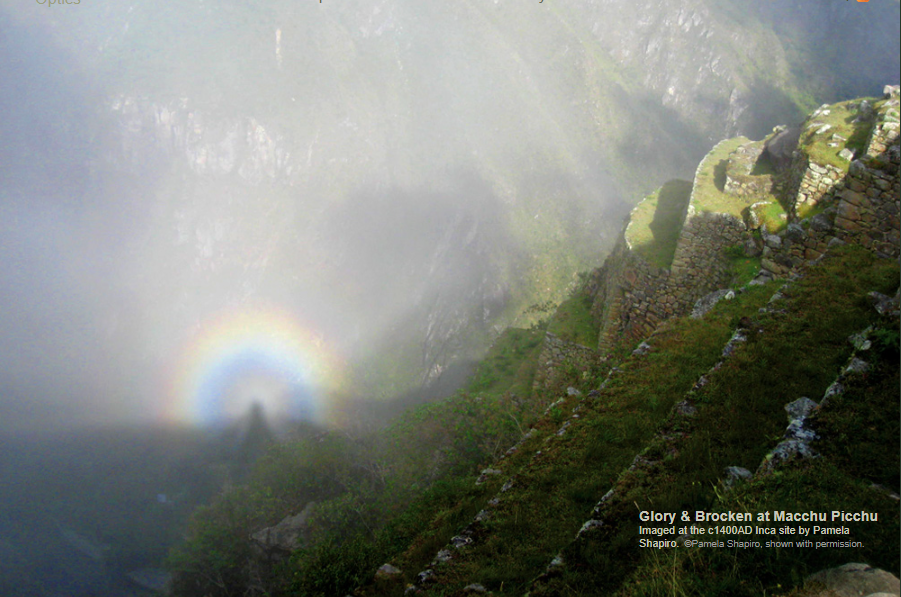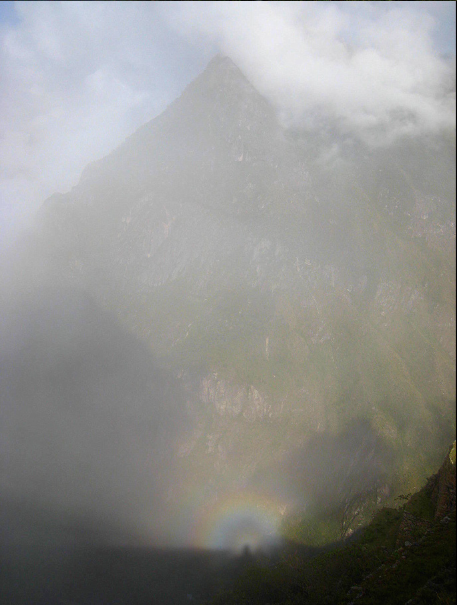Glory at Macchu Picchu
Glory at Macchu Picchu: An Enigmatic Atmospheric Optics Phenomenon
Macchu Picchu, the ancient Inca site nestled amidst the Andes Mountains, is not only a marvel of architecture and history but also a place where nature showcases its breathtaking beauty. In the early morning hours, when sunlight pierces through the mountain mist, an extraordinary optical phenomenon can be witnessed. Two captivating effects, known as the glory and the Brocken spectre, emerge, revealing the fascinating extremes of optics.
The Glory: A Dazzling Display of Colored Rings
The glory is a mesmerizing sight to behold - a radiant spot surrounded by a series of vibrant, concentric rings. This phenomenon is a result of sunlight interacting with tiny mist droplets suspended in the air. Waves of light are scattered backward, almost in the direction from which they originated, creating this ethereal display. Unlike classical ray optics, which considers light as traveling along straight lines, the glory belongs to the realm of wave optics.
The Intricacies of Wave Optics
When objects are much smaller than the wavelength of light, wave optics takes precedence over classical ray optics. In this domain, light is perceived as sets of spreading transverse waves that interact in intricate and sometimes counterintuitive ways with objects and surfaces. The waves scatter or diffract, leading to complex interference patterns. The glory is a remarkable example of such wave scattering.
The Elusive Nature of the Glory
While we can marvel at the glory's splendor, its formation remains shrouded in mystery. Unlike other wave scattering effects, such as the rainbow which has a well-understood classical wave optics equivalent (the fogbow), the glory defies easy explanation. Attempts to construct a model using classical ray optics result in impossible ray paths. Although mathematical theories accurately describe and predict the glory, we struggle to grasp its visual or mechanical representation.
The Complexity of the Glory's Formation
To comprehend the formation of the glory, we must delve into the intricate interplay between waves and mist droplets. Reflection, as well as waves traveling on and near the surface of the droplets, contribute to this phenomenon. However, a comprehensive understanding of the physical mechanisms involved remains elusive. The glory's formation occurs on a nano-scale, far removed from our macro experiences, highlighting the multi-layered nature of reality.
The Brocken Spectre: A Photographer's Monstrous Shadow
Accompanying the glory at Macchu Picchu is another captivating sight - the Brocken spectre. This phenomenon occurs when the photographer's shadow is cast onto the mist, creating a larger-than-life silhouette surrounded by a halo of light. The Brocken spectre is an example of classical optics, where light interacts with objects much larger than its wavelength.
The Magic of Macchu Picchu
Macchu Picchu's unique geography and atmospheric conditions create an enchanting backdrop for these captivating atmospheric optics phenomena. As sunlight dances through the mountain mist, nature puts on a dazzling display of light and color. Visitors to this ancient Inca site are treated to a visual spectacle that reminds us of the wonders and complexities of the natural world.
In conclusion, Macchu Picchu offers not only a glimpse into the rich history of the Inca civilization but also an opportunity to witness the glory and the Brocken spectre. These awe-inspiring atmospheric optics phenomena remind us of the intricacies and mysteries that lie within the realm of light and waves. While we may not fully grasp their formation or have easily visualized explanations, they serve as a testament to the boundless beauty and complexity of nature. So, next time you find yourself at Macchu Picchu, take a moment to embrace the glory and marvel at the enigmatic wonders that surround us.

Glory & Brocken at Macchu Picchu
Imaged at the c1400AD Inca site by Pamela Shapiro. ©Pamela Shapiro, shown with permission.

Sunlight shining through early morning mountain mist has produced two effects that illustrate the two extremes of optics. One is the glory, the bright spot surrounded by coloured rings. The other is the photographer�s shadow which in a more monstrous or menacing form was named a Brocken Spectre.
Classical ray optics considers light as traveling along narrow lines or rays which can be refracted or reflected but are otherwise straight. The photographer�s shadow, a tunnel of shaded air through the mist, is fully understandable and predicted using classical optics. Classical optics works when light interacts with objects, like photographers, that are considerably larger than its wavelength.
Reduce the size of the object and light no longer neatly travels or shadows along straight lines or cleanly reflects or refracts. Instead we are in the domain of wave optics where light must be recognised as sets of spreading transverse waves that interact in complex and sometimes non intuitive ways with objects and surfaces. The waves scatter � �diffract�. They can interfere constructively or destructively to form fringed diffraction patterns of which the glory is one.
The glory is the result of waves scattered almost backwards into the direction from whence it came by tiny mist droplets. It has no counterpart whatsoever in classical ray optics.
Partly for this reason there is no readily understandable explanation or easily visualised physical model of precisely how it forms. Contrast this with another wave scattering effect, a fogbow, which has the rainbow as its classical wave optics equivalent. Attempts to construct a glory using ray optics lead to impossible ray paths. We know that reflection of a sort inside the droplets is involved together with waves traveling on and near their surface but that is about all. This is not to imply that the physics is lacking, mathematical theories describe and predict the glory perfectly but regrettably not in terms that we can grasp visually or mechanically.
Reality is multi-layered and the nano-world of waves and scattering is much removed from our limited macro experiences.
Note: this article has been automatically converted from the old site and may not appear as intended. You can find the original article here.
Reference Atmospheric Optics
If you use any of the definitions, information, or data presented on Atmospheric Optics, please copy the link or reference below to properly credit us as the reference source. Thank you!
-
<a href="https://atoptics.co.uk/blog/glory-at-macchu-picchu/">Glory at Macchu Picchu</a>
-
"Glory at Macchu Picchu". Atmospheric Optics. Accessed on November 26, 2024. https://atoptics.co.uk/blog/glory-at-macchu-picchu/.
-
"Glory at Macchu Picchu". Atmospheric Optics, https://atoptics.co.uk/blog/glory-at-macchu-picchu/. Accessed 26 November, 2024
-
Glory at Macchu Picchu. Atmospheric Optics. Retrieved from https://atoptics.co.uk/blog/glory-at-macchu-picchu/.